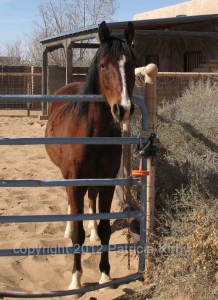Ask any horse owner for the defining characteristics of equines and they’ll likely say “accident prone” and “frequently paranoid.”
The second is a function of the horse’s position on the food chain, herbivore, aka, a carnivore’s happy meal. While the average horse is as likely to be eaten by a lion as I am to win the lottery, most equines retain an instinctive wariness of anything that smacks of predator. In the modern setting this might mean a black trashbag or a small child dressed in a Halloween costume (horse eating gnome).
Non-horsey folks, having seen movie horses who gallop without hesitation toward gunfire, think horses arrive, out-of-the-box, brave and cooperative. Horses are smart and can be trained (desensitized) to tolerate all manner of scary things. Hollywood horses, because they have to carry expensive commodities–actors–are particularly bomb proof. But even a horse who’s utterly unfazed by gunfire, might come unglued at the sight of your grandma and her purple hat with the peacock feathers.
Writers really should take note of this. If your fictional equines are calm, tractable beasts of burden, you’re missing out on a prime opportunity to torture your characters.
Horses are also Murphy’s Law in action. You could wrap a horse in bubble wrap and put him in a padded stall, and I gay-ron-tee, the next day, when you return, he’ll have found a way to hurt himself. Often the biggest expenses of owning a horse isn’t food; it’s the vet bills.
Case in point, the Wonder Horse. My husband and I grew up horsey, so when we built the paddock, we went with sturdy metal posts and fencing made specifically for horses. Throughout the years, the metal posts held up to horse’s best attempts to destroy them (in particular, the equine habit of using anything upright as a itch-scratching post). In his quest for the weeds on the other side of the fence, however, horse prevailed over fencing, bending up the bottom edges as he reached for the choicest bits of tumbleweeds. For the past couple of years, the fencing stuck out into the paddock in a mess of half rusted, sharp metal edges. And somehow, despite my grumblings– “That’s gonna be a vet bill”–he never got more than a scratch. (I, OTOH, ripped several large gashes in my leg.)
In January, my beloved husband decided to deal with the problem. He rented a small tractor and leveled the ground. Then, instead of ordinary fencing, he welded on extra safe horse panels.
Last week, early in the morning, I stagger out to the barn to feed and clean up after the Wonder Horse. He’s waiting for me by the front gate. As I approach, he turns for his porch and feeder, and I notice a nasty looking scratch on his right hind leg, just above the fetlock. “How in the hell did you manage that?” I glance around the paddock, but don’t see any obvious problems. He rattles the feeder and stamps his hooves; I feed him and get out the wheelbarrow. Time to shovel up the future compost.
I push the wheelbarrow across the paddock and glance at his leg again. “Shit!” The inside of his right leg is a bloody mess with at least five square inches of flayed skin and several more scratches.
The hose is frozen, so the only option is the purple antiseptic. The Wonder Horse is a huge drama queen, so this happens with loads of snorting and kicking: “It stings!” Next, I investigate the scene. It doesn’t take long to find the problem: a gap between panels that he somehow, against all odds, found and shoved his leg through. The panels are bent and the ground is littered with chunks of white hair and skin. It looks like someone skinned a small animal. Based on my initial assessement of the injury, I decide it isn’t vet worthy. By the afternoon, it’s swollen, but I stick with the plan; no vet unless it still looks terrible at the end of the week.
The plan goes awry when, the next day, after poking around on the Internet, I convince myself he’s going to die of some horrible infection if I don’t hose out the wound. The Wonder Horse has good ground manners; I do most maintenance stuff–grooming, hoof trimming–with him at liberty in his paddock. My reasoning is simple. I could tie him up, but if he freaks out, without an escape, he’ll stomp on me. He lets me do anything to him, but I’ve never really done much to him involving water. He’s the equine Wicked Witch of the West; he hates water. I’ve ignored the issue, even though I know, it will someday bite me in the ass.
Long story short; he won’t let me get near his wound with water; we both have a tantrum; and I stomp into the house and call the vet. This is me, having a meltdown, because my usually cooperative horse has turned into an 1100-pound hell thing.
Of course, two days later, when the vet finally arrives, we’ve both chilled out, and I’ve decided the injury isn’t vet worthy. Again.
It is, however, time for spring vaccinations, so I get a small revenge in letting the vet stick him with needles. I pay the vet–cha-ching!–and she leaves me with my now very huffy horse.
So, uh, guess what’s on my agenda this summer? Training the horse to tolerate that most essential of elements, water.




It’s like my dog and the vet. I swore I would take her regularly, just for a treat, so she wouldn’t be pissy at the vet.
*face fall
Didn’t do it. Now? She hates the vet and gets stupid about going. Why didn’t I follow my first plan?
And making note that should I use a horse in a book, I will check with you on appropriate horse behavior. And not wear a peacock in my tricorn when I visit!
Maureen. I know. It’s like you know you should deal with the problem, but…look something shiny.
Dealing with the horse’s water phobia means hauling the hose out the barn, then dealing with a large, panicking animal and… mud.
I’d love you to wear the tricorn out to the barn. Now, that would be a fun training exercise! Truly, it would be easier to teach him not to be afraid of the hat than to love being wet. He really hates water.
Judith Tarr released a collection of her horse blog entries last year (she of the ownership of 9 Lipizzans in Arizona) especially for writers who want to have believable horses: Writing Horses at Book View Cafe.
Cool. I’ll check it out. When it comes to horses, it’s a matter of knowing waayy too much; I’ve stopped reading novels because of horsey inaccuracies. It would be lovely if more writers did a bit of research rather than going off of what they think they’ve learned from the movies.